Morris & Fan. Reservoir Sedimentation Handbook
Подождите немного. Документ загружается.

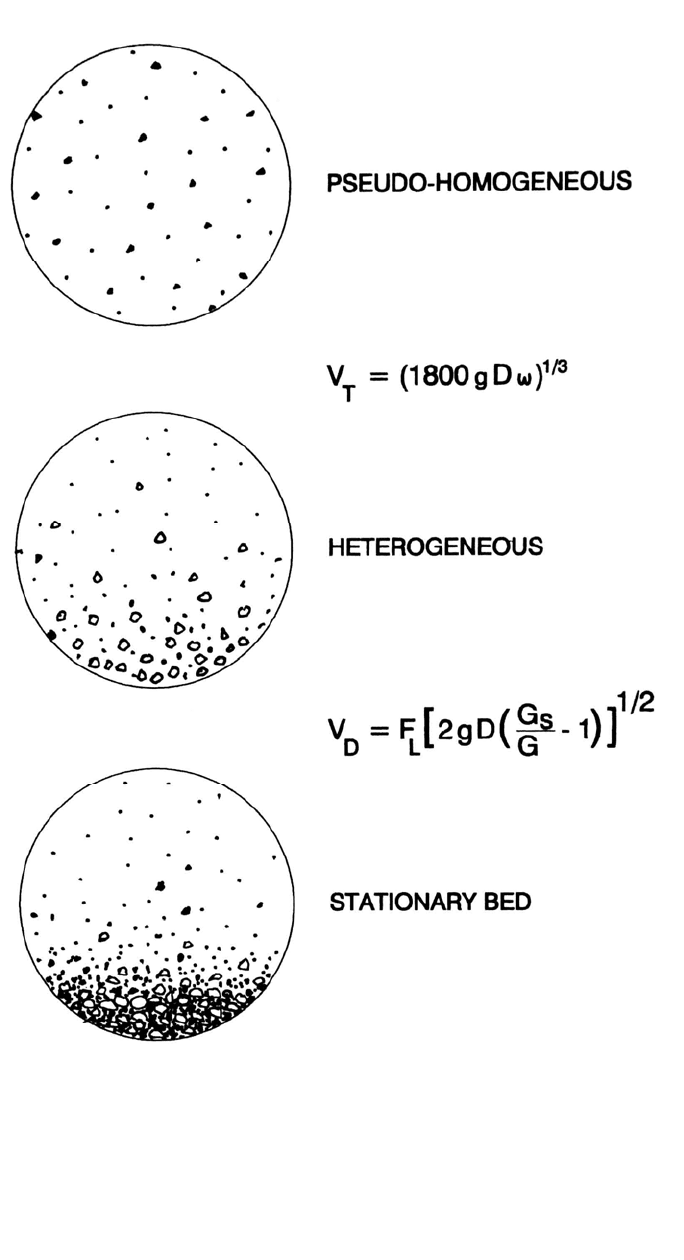
SEDIMENT EXCAVATION 16.36
FIGURE 16.19 Transport regimes for sediment transport in pipelines based on Graf (1971).
The vertical distribution of fine, nonsettling sediment remains homogeneous for all flow
conditions. Coarse sediment may exhibit a vertical concentration profile, depending on the
flow velocity. Equations for the transition velocity between each regime are shown. At highe
r
velocities within the heterogeneous regime all sediment will be in suspension, and at lowe
r
velocities within this regime coarse material will be transported as bed material which rolls o
r
bounces along the pipeline without forming a stationary bed.
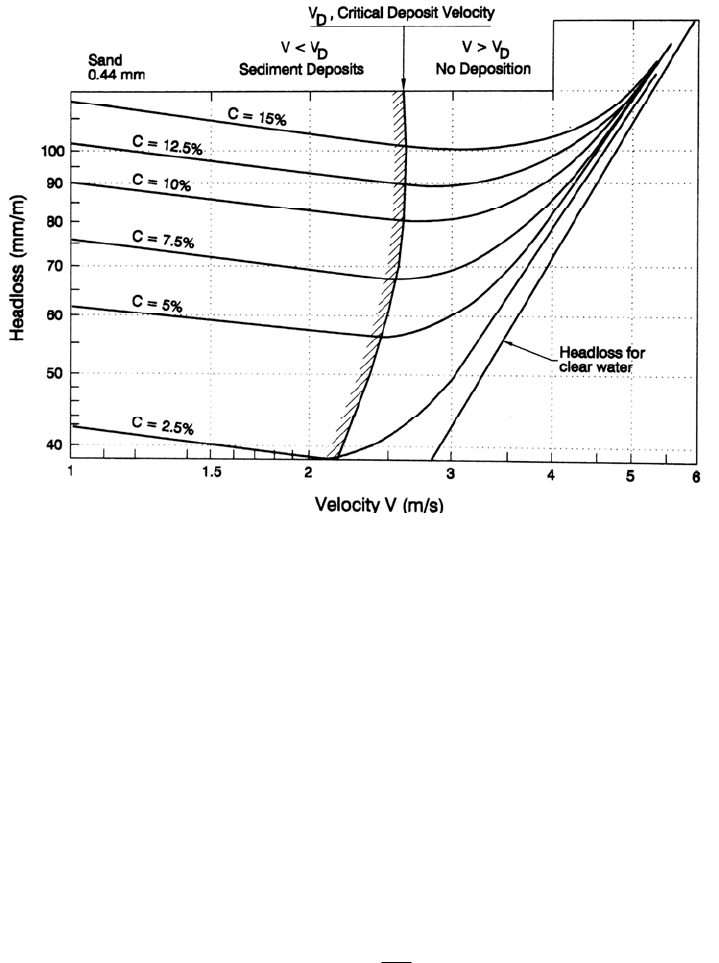
SEDIMENT EXCAVATION 16.37
FIGURE 16.20 Head loss as a function of velocity for different sediment concentrations.
Minimum head loss occurs at the critical deposit velocity, the lowest velocity that sustains
all material in motion without forming a stationary bed (redrawn from Condolios an
d
Chapus, 1963).
Pipeline blockage can occur when V< V
D
, and may be caused by: an increase in the
concentration or grain diameter of the material being dredged, if flow velocity decreases
or stops while the pipeline contains solids, or because of pipeline leakage. In selecting
pumping units, or designing a gravity system, it is important that the head-discharge
characteristics of the system be compared to the head loss curves for the pipeline system
corresponding to the maximum grain size and concentration that can be expected, to
ensure that the system always operates within the nonsettling region. Much lower
pipeline velocities can be safely used for pumping fine-grain, nonsettling material, as
compared to coarse sediment.
The Durand-Condolios relationship defines the critical deposit velocity, which
separates the heterogeneous (deposit-free) regime from the moving bed regime. The
critical deposit velocity V
D
is given by:
2/1
12
G
G
gDFV
s
LD
(16.13)
The coefficient value F
L
may be estimated from Fig. 16.21. The transition point from
heterogeneous to homogeneous flow is given by:
V
T
= (1800gDω)
1/3
(16.14)
In these equations V = mean flow velocity (m/s, ft/s); C = volumetric concentration of
sediment expressed as a decimal value; d
= sediment diameter (mm); D = pipe diameter
(m, ft), g = 9.8 m/s or 32.2 ft/s; ω = sediment fall velocity (m/s, ft/s); and G and G
s
=
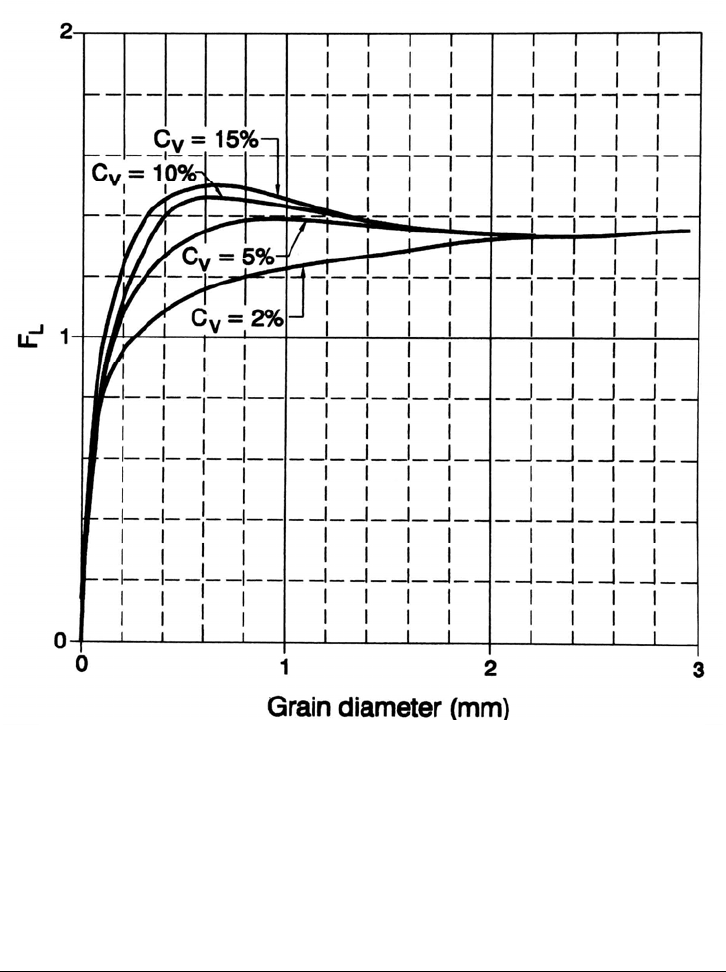
SEDIMENT EXCAVATION 16.38
FIGURE 16.21 Variation of coefficient F
L
as a function of grain diameter (Durand, 1953).
specific gravity of the fluid and sediment grains, respectively. These velocity equations
are dimensionally homogeneous. For example, for D = 0.25 m, d = 2 mm (coarse sand),
G
s
= 2.65, G = 1.0, g = 9.8 m/s
2
, C
v
= 0.15, and taking a value of F
L
= 1.34 from Fig.
16.21, compute V
c
= 3.8 m/s from Eq. 16.13. Compute the setting velocity ω = 0.147 m/s
from the Rubey equation (Eq. 5.23), and compute V
T
= 8.6 m/s from Eq. 16.14.
16.9 PIPELINE HEAD LOSS
There is no simple and clear-cut method for determining slurry head losses in hydraulic
dredging pipelines. Dredge slurries typically contain a range of grain sizes. Furthermore,
the grain size distribution, density, and viscosity can all change rapidly as the dredge
moves through nonhomogeneous beds of sediment. Some silt-clay mixtures exhibit
properties of a Bingham fluid, which is quite different from a newtonian fluid. A number
of researchers have found that the presence of a significant concentration of clay in the
slurry can decrease friction losses compared to coarse sediment alone. Accordingly,
methods for estimating head loss in dredged pipelines only approximate field conditions.

SEDIMENT EXCAVATION 16.39
16.9.1 Friction Losses by Slurry Density Approach
One approach to computing the friction head loss in a slurry pipeline is to use the Darcy-
Weisbach friction loss equation, but express head loss in terms of the equivalent column
of slurry instead of clear water (Herbich, 1992). The Darcy-Weisbach equation may be
expressed as follows:
H
f
f
L
D
V
2
2g
(16.15)
To express unit friction loss S in terms of the column of slurry with a specific gravity of
G
m
,
the equation may be rearranged as:
SG
m
fV
2
2gD
(16.16)
To solve for friction loss based on discharge in a circular pipe:
SG
m
fQ
2
0.6169D
5
(2g)
(16.17)
where S = friction loss per unit length of pipe (m/m or ft/ft), G
m
= specific gravity of the
mixture or slurry, Q = discharge (m
3
/s, ft
3
/s), D = pipe diameter (m, ft), f = Darcy-
Weisbach friction factor, and g = gravitational constant. The Darcy-Weisbach equation
may be solved with any dimensionally consistent units.
In this method the specific gravity of the fluid being pumped is the only variable; it
does not account for differences in the grain size of the slurried material. The specific
gravity of the mixture G
m
may be computed from the volumetric sediment concentration
C
v
as
G
m
= C
V
(G
s
- G) + G (16.18)
where G = specific gravity of water and G
s
= specific gravity of sediment particles.
Methods to compute the friction factor in a slurry pipeline were presented by Schiller
(1992). Little error is introduced by assuming that the Darcy-Weisbach friction factor f
for a slurry is the same as for clear water, as read from the Moody diagram. Because of
the abrasive action of sediment, which polishes the pipeline interior, the value of the
Darcy-Weisbach friction factor f may be determined from the Moody diagram for
"smooth pipe" conditions, or by the following equations. For laminar flow in circular
pipe (Re<2000):
f
64
Re
(16.19)
For smooth pipe in the turbulent range (Re >4000), the value off may be determined by
iteration using the following equation:
8.0)(Re log 0.2
1
5.0
5.0
f
f
(16.20)
This equation can be easily solved using a hand calculator having an iterative equation
solver. For the range of Reynolds numbers from 40,000 to 60,000,000, the solution may
be approximated by:

SEDIMENT EXCAVATION 16.40
f =
0.10408 (Re - 22,000)
-0.157
(16.21)
16.9.2 Minor or Local Losses
Minor head losses H
m
at bends and valves may be computed as a function of velocity V
by:
H
m
KV
2
2g
(16.22)
using the head loss coefficient values of
K shown in Table 16.6. It is more convenient to
convert minor losses into an equivalent length of straight pipeline, which is added to the
TABLE 16.6 Coefficient Values for Minor Losses
System component K
Plain end suction 1.0
Globe valve, wide open 10.0
Angle valve, wide open 5.0
Gate valve, wide open 0.2
T, through side outlet 1.8
Elbows:
90° short radius 0.9
90
0
long radius 0.6
45° elbow 0.4
Stern swivel 1.0
Ball joints:
Straight 0.1
Medium cocked 0.4 to 0.6
Fully cocked (17°) 0.9
Discharge 1.0
Source: Adapted from Herbich (1992)
total pipeline length for the purpose of frictional head loss computations. The equivalent
length is given by:
L
e
KD
f
(16.23)
where K = sum of all K values for the individual components along the pipeline.
16.9.3 Turner's Friction Loss Graph
Friction loss in a slurry pipeline will vary as a function of the sediment grain size. Turner
(1996) recommends use of the Hazen-Williams equation and the friction coefficient C
values shown in Fig. 16.22 to estimate friction loss in a slurry pipeline transporting
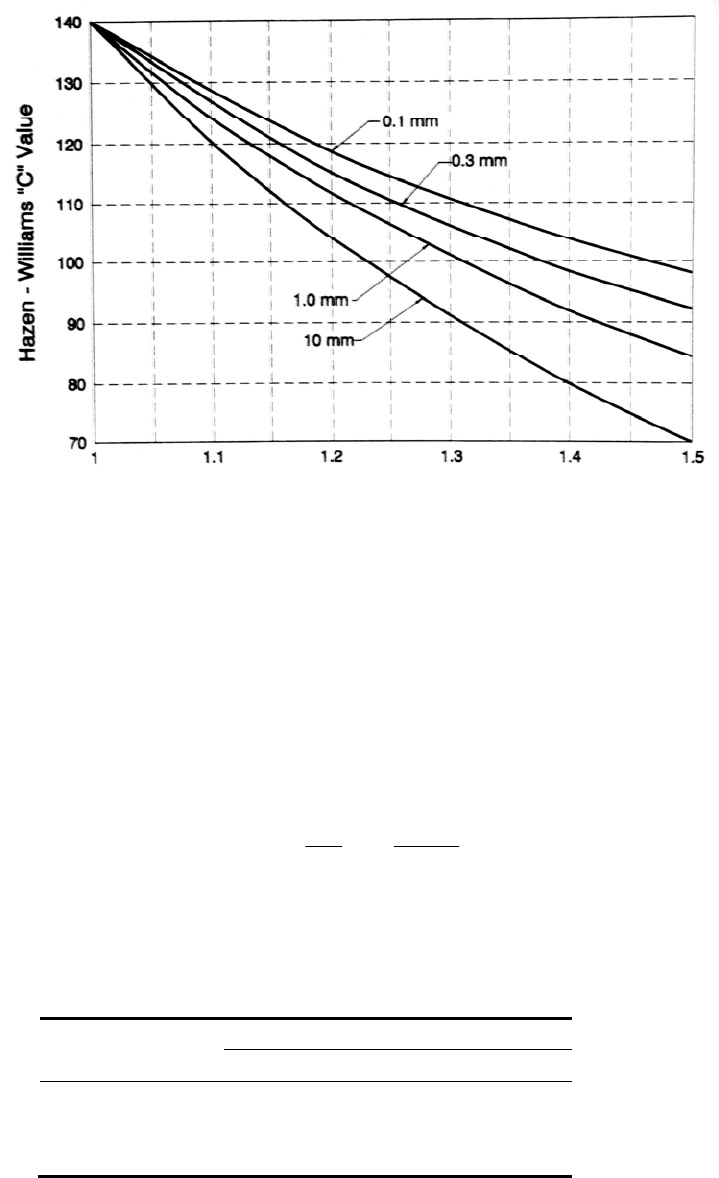
SEDIMENT EXCAVATION 16.41
coarse sediment. The C values in the graph reflect the variation in friction losses as a
function of the grain size of coarse sediment as well as the specific gravity of the slurry.
Silts have a somewhat lower friction value than fine sand. For silts use the slurry density
approach described in section 16.9.1, applying a C coefficient appropriate for clear water
and multiplying head loss by the specific gravity of the slurry. The C coefficient for clays
is difficult to determine without specific field data. The "lubricating" effect of clays,
observed under some conditions, is elusive and should not be planned on without specific
data.
The Hazen-Williams equation can be expressed in the following form:
8655.4
85.1
85.1
100
D
Q
C
BS
(16.24)
where S = friction loss in column of water (not column of slurry) per unit length of pipe
(m/m, ft/ft), C = Hazen-Williams coefficient for friction loss, Q = discharge, D =
pipeline inside diameter, and B = coefficient value depending on the system of units, as
given below.
Units
Coefficient B Q D S
2.13×10
-3
m3/s m m/m
2.08×10
-3
gal/min in ft/ft
9.43×10
-4
ft3/s ft ft/ft
FIGURE 16.22 Variation in the Hazen-Williams friction coefficient C for a dredge slurry
pipeline, as a function of grain size and specific gravity of the slurry (redrawn from Turner,
1996).

SEDIMENT EXCAVATION 16.42
The curves in Fig. 16.22 have been developed from practical data acquired over many
years from many sources. On the basis of field observations, the C value of 140 for clear
water is considered representative of both steel and polyethylene pipelines after they have
been subject to wear. Because these values are based primarily on field experience rather
than laboratory data, they should not be considered precise. This is especially true
because the slurry discharged from a dredge never has a constant composition. Also, a
significant concentration of clay can have a lubricating effect and reduce friction losses,
thereby increasing the C value by as much as 10 points. On the basis of practical
experience, Turner also indicates that local losses from fittings along a dredge pipeline
often approximate 10 percent of the frictional losses for straight pipe.
16.9.4 Total Pipeline Head Loss
The computation of total head losses along a dredge pipeline includes friction losses,
local or minor losses at bends and valves, entrance and exit losses, and static head. In a
slurry pipeline, the static head must be computed for the specific gravity of the slurry, not
pure water, and a positive static head is required to lift the column of slurry in the
pipeline from the bottom to the surface of the water body.
16.10 CLOSURE
Sediment excavation is a costly method for sediment management and the recovery of
reservoir capacity, but it may be required in many circumstances. The magnitude and
frequency of sediment excavation can be minimized by reducing erosion in the tributary
watershed, and employing design and management techniques such as sediment routing
to minimize sediment deposition in the impoundment.
The potential for the continued excavation of sediments depends on the availability of
sediment disposal sites, and if excavation or dredging is to be relied on as a long-term
management tool, disposal areas of adequate capacity or with reuse potential must be
available.

CHAPTER 17
DECOMMISSIONING OF DAMS
17.1 INTRODUCTION
As dams age, decommissioning becomes an issue that must be considered by some
owners. Decommissioning of dams and hydroelectric projects requires that they be
rendered inoperative in a manner that is safe and environmentally acceptable. In some
cases it may entail decommissioning of appurtenances while the dam is left intact, and in
other cases the dam may be partially or completely removed. The requirements for
decommissioning will be determined by unique conditions at each site.
Decommissioning may be implemented to satisfy either economic, environmental,
or regulatory requirements. When projects become uneconomic to operate, owners may
voluntarily decide to decommission. In other cases, the demand to decommission may
be determined by environmental or regulatory requirements. At some sites in the United
States and Europe, project decommissioning and dam removal is being considered to
restore fisheries (e.g., salmon). The U.S. Federal Energy Regulatory Commission
(FERC) declared in a policy statement before Commissioners on December 4, 1994 that
the Commission has the right to demand decommissioning of a project when
considering an application for relicensing.
Decision making to determine the feasibility of voluntary decommissioning and dam
removal is a complex process, especially when fluvial conditions are to be reestablished
along the previously impounded reach, potentially mobilizing sediment that has
accumulated for many decades. Decommissioning also includes consideration of a
number of issues in addition to sediment management. Various decommissioning and dam
removal options can be evaluated by making use of decision-making systems such as the
Analytical Hierarchy Process (Saaty, 1990). A worked example of how this process can
he applied to make such decisions is published in the American Society of Civil
Engineers' Guidelines for Retirement of Dams and Hydroelectric Facilities, currently in
preparation.
Sediment management is a significant part of the decommissioning process. The cost
of sediment management for the proposed decommissioning of the Elwha River dams
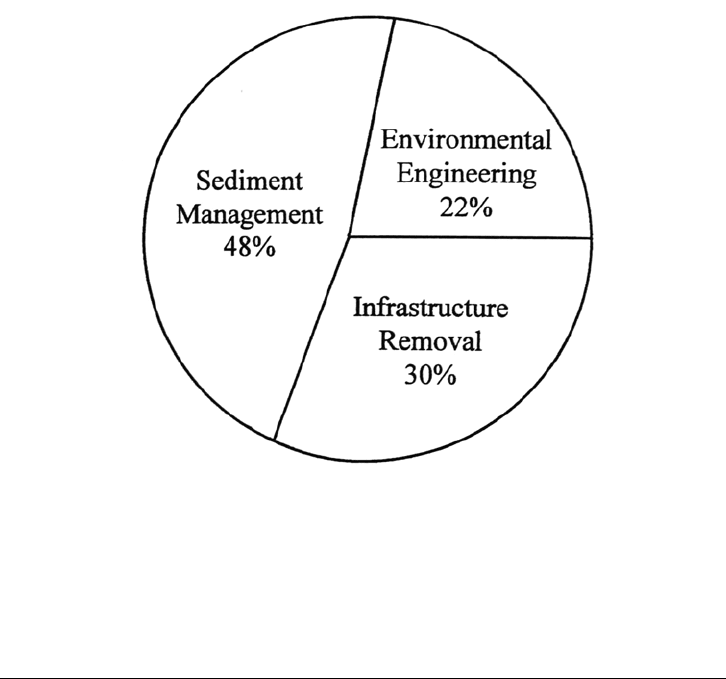
DECOMMISSIONING OF DAMS 17.2
on the Olympic Peninsula, Washington State (U.S. Department of Interior, 1994)
represents nearly half the total construction cost of the proposed decommissioning
project. Pansic et al. (1995) found that sediment management cost is a major portion of
the total cost of decommissioning (Fig. 17.1 ).
This chapter provides an overview of the types of sediment management issues
typically associated with the decommissioning of dams. Basic sediment management
options are discussed and examples are presented.
FIGURE 17.1 Relative magnitude of costs associated with decommissioning of dams.
17.2 DAM REMOVAL OPTIONS
There are three basic structural alternatives for decommissioning a dam. The dam can be
left in place, partially breached, or completely removed. Either partial or complete
removal may be accomplished as a staged process extending over a period of years to
reduce the rate of sediment release.
Selection of the appropriate sediment management strategy is intimately related to
the dam removal strategy, and, given the importance of sediment management, it will
typically be a primary factor determining which dam removal strategy is to be
implemented.
The basic sediment management options can be classified into four basic categories:
1. Leave the sediment in place;
2. Allow natural erosion to remove some or all of the sediment;
DECOMMISSIONING OF DAMS 17.3
3. Construct a channel through the deposits while off-channel deposits are stabilized
and maintained in place; or
4. Remove all sediment deposits by mechanical excavation or hydraulic dredging.
The option to leave the sediment in place is mainly associated with the option of retaining
the dam structure, while the other sediment management options are associated with the
dam removal alternatives.
17.2.1 Leave Dam in Place
The simplest decommissioning option is usually to leave the dam in place. This option
will not be feasible when dam removal is desired for environmental purposes such as
restoring migratory pathways or when it will result in unsafe conditions. The dam
engineering associated with this decommissioning option is directed at removal and
closure of appurtenant structures such as power houses, turbines, and power lines.
Because engineering requirements to retire the dam structure are often minimal, this
option may result in immediate savings, but may imply an indefinite commitment to
maintain, supervise, and operate certain elements of the facility. For example,
maintenance and operation of gates for flood control may be required to ensure the safety of
downstream communities. This option may also be desirable when the reservoir sediments
contain contaminants which are costly to remove and which should not be released
downstream.
The sediment management strategy that is intuitively associated with this decommis-
sioning option can be fairly simple, i.e., leaving the deposited sediment in place. How-
ever, the long-term consequences of sediment accumulation must be considered. Future
deposition of sediment may raise the bed elevation in the river reaches upstream of the full
supply elevation of the reservoir pool and may also accumulate before the dam, causing
problems to communities and infrastructure, such as increased flooding, blockage of water
intakes, or reduced capacity of infrastructure such as bridges to pass floods, and may also
affect the structure of the dam itself. When the reservoir continues to accumulate sediment,
adverse consequences downstream due to the cutoff of the sediment supply will continue.
Future dam removal will become increasingly difficult if sediments continue to
accumulate.
17.2.2 Partial Dam Removal
Under partial removal, or breaching, only a portion of the dam structure is removed. The
breach may extend to the original stream thalweg, or the new crest may be established at
some level between the existing crest and the original thalweg. Figure 17.2 illustrates the
concept of partial breaching. Breaching lowers the pool elevation, exposing and potentially
eroding sediment deposits in the dewatered portion of the pool, while sediment closer to the
dam and below the new crest level will remain trapped behind the dam. When only a part
of the dam is removed, the remaining section of the dam may still have a retarding effect
on flow at high discharges. This can reduce the flow velocity during large events and cause
continued sediment deposition in the reach upstream of the partially breached dam.
Sediments eroded from the delta area may also deposit behind the breached dam.
17.2.3 Complete Dam Removal
Complete removal of a dam occurs when the entire structure is removed in a relatively
short period of time, restoring the original cross-sectional shape of the valley at the dam
